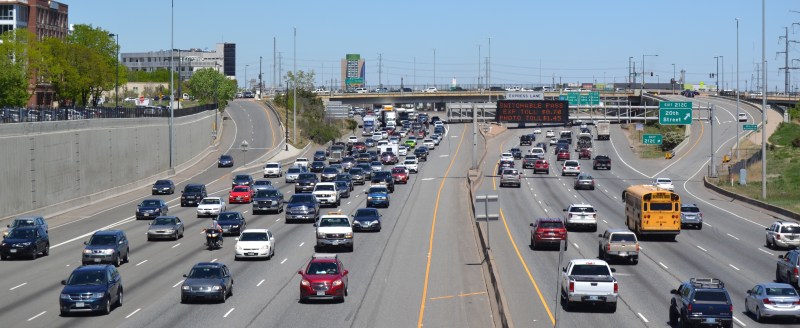To Beat Congestion, Colorado Can’t Rely on the Same Bag of Road Expansion Tricks

An additional 1.2 million people will call Colorado home by 2030, according to the State Demography Office, and they’ll have to get around somehow. No one wants to sit in traffic, but unless Colorado DOT changes its 1950s approach to congestion management, people will be spending more time behind the wheel.
It doesn’t have to be that way.
Instead of sticking with the same old road expansion strategies, Colorado should be converting highway lanes to high-occupancy/toll (HOT) lanes and putting that revenue toward better transit, according to a new report from the Southwestern Energy Efficient Project [PDF].
The report examined the expansion of I-25 known as T-REX. After CDOT finished widening I-25 in 2005, it took less than five years for the lanes to fill back up with cars. It was a classic case of induced demand — the principle that adding lanes to congested roads will simply lead more people to drive.
A better solution is to get more out of the roads we already have. By turning conventional highway lanes into HOT lanes, argues SWEEP, roads will be able to handle more people in the same amount of space, and Colorado will avoid road widenings it can’t afford.
“Our message is that people complain, obviously, about congestion and traffic right now,” said Mike Salisbury, who co-authored the study. “And what’s gonna happen in the next 20 years when you add a million more people in the Denver metro area? It’s going to be infinitely worse unless you do something to allow this corridor to handle more people.”
The average commuting vehicle in the Denver region contains 1.08 people, according to the Denver Regional Council of Governments. Basically, almost everyone is driving solo. What if incentives shift so carpooling and transit become more attractive?
SWEEP proposes a system where cars with three or more people would use these managed lanes for free, while single-occupancy vehicles would pay a use fee that varies according to demand, resulting in more people using I-25 in fewer cars.

CDOT could raise between $13 million and $20 annually from HOT lanes on I-25, according to the report. That money should fund better bus, bike, and pedestrian connections to light rail along the corridor, as well as transit passes and fare incentives to increase ridership, the authors conclude.
“While it’s not a silver bullet, there’s certainly potential to get more people to use the various lines that serve that corridor… there’s a lot of potential to get more people to use transit,” Salisbury said.
Currently, RTD’s E, F, and H lines along I-25 carry about 43,000 trips each weekday. Not too shabby, but they have room for more. The lines operate at 64 percent of capacity, on average, the report found. Transit is “doing a lot of heavy lifting on the corridor already, and I think there’s room for it to do a little bit more,” Salisbury said.

Rather than convert existing lanes to HOT lanes, it’s far more common for DOT’s to widen a highway first — like what CDOT did on U.S. 36, and is trying to do on I-70. The politics of repurposing existing highway lanes can be tricky, and so can the red tape.
Right now, tolling existing lanes requires the approval of local governments and the feds, Salisbury said. But that’s not an excuse to avoid tough but necessary decisions.
“I think it’s incumbent upon CDOT to think creatively about how to make [I-25] work better for everybody, and they’re gonna be the lead agency on this,” Salisbury said. “We can’t sit around and wait for automated platooning vehicles to magically solve capacity problems. We understand that this is not going to be a politically easy thing, but we think it makes much more sense than any of the other alternatives out there.”


